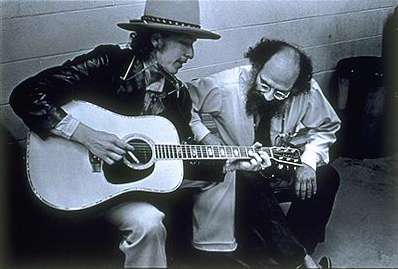Elsa Dorfman

Elsa Dorfman (born April 26, 1937) is an American portrait photographer who works in Cambridge, Massachusetts. She is now known for her use of a large-format instant Polaroid camera.[1]
Life and work
Her principal published work, originally published in 1974, is Elsa's Housebook - A Woman's Photojournal,[2] a photographic record of family and friends who visited her in Cambridge when she lived there during the late 1960s and early 1970s. Many well known people, especially literary figures associated with the Beat generation, are prominent in the book, including Lawrence Ferlinghetti, Allen Ginsberg and Peter Orlovsky, Gary Snyder, Gregory Corso, and Robert Creeley, in addition to people who would become notable in other fields, such as radical feminist Andrea Dworkin and civil rights lawyer Harvey A. Silverglate (who would become Dorfman's husband). She has also photographed staples of the Boston rock scene such as Jonathan Richman frontman of The Modern Lovers, and Steven Tyler of Aerosmith.

Dorfman moved to New York City in 1959 and found a job as a secretary to the editors at Grove Press, a leading Beat publisher.[3] When she later moved home to Cambridge to pursue her master's degree, she called herself the "Paterson Society" and began arranging readings for many Beat authors who had become friends, maintaining an active correspondence with them as they traveled the world. By 1962, she was teaching fifth grade. A year later, in 1963, Dorfman began working for the Educational Development Corporation whose photographer, George Cope, introduced her to photography in June 1965. She made her first sale two months later, in August 1965, for $25 of a photograph of Charles Olson which was used on the cover of his book The Human Universe. Due to economic limitations, she did not buy her own camera until 1967, when she sent a check for $150 to Philip Whalen who was then in Kyoto, Japan, and he in turn enlisted Gary Snyder, who could speak Japanese, to purchase the camera and mail it to her. In May 1968, she moved into the Flagg Street house which would become the basis of her Housebook.
She is now known for her use of a Polaroid 20 by 24 inch camera (one of only 6 in existence),[4] from which she creates large prints. She has photographed famous writers, poets, and musicians including Bob Dylan and Allen Ginsberg.[5] Due to bankruptcy, the Polaroid Corporation entirely ceased production of its unique instant film products in 2008. Dorfman stocked up with a year's supply of her camera's last available 20 x 24 instant film.[1]
Raising awareness
Dorfman suggests elements of healing through her work in a variety of ways. She has photographed terminal cancer patients, emphasizing their dignity. In 1995, she collaborated with graphic artist Marc A. Sawyer to illustrate the booklet 40 Ways to Fight the Fight Against AIDS. She photographed people, both with and without AIDS, each engaged in one of forty activities that might help AIDS victims in their daily life. The photographs were exhibited 1995 at the Lotus Development Corporation in Cambridge, in Provincetown and in New York City. The artist donated the costs of producing the photographs for this project.[6]
Dorfman co-stars in the documentary No Hair Day (1999) as she's taking the portraits of three women undergoing treatment for breast cancer.
References
- 1 2 Mark Feeney (March 16, 2008). "Instant karma". The Boston Globe. Retrieved 2014-03-15.
- ↑ Elsa Dorfman's Housebook
- ↑ Dorfman explains her background in her Housebook The Camera
- ↑ According to her web site FAQ, Frequently Asked Questions about Elsa Dorfman's Portrait Photography on the Polaroid 20x24 Camera
- ↑ "Allen Ginsberg on Flagg Street, 1973 at the Jewish Museum (New York)". Thejewishmuseum.
- ↑ Hoffmann, K. (1999). Elsa Dorfman: Portraits of Our Time. Woman's Art Journal Vol. 20, No. 2, 1999, 28.
External links
| Wikimedia Commons has media related to Elsa Dorfman. |
- Official website
- "Elsa Dorfman Photographs, 1957-1970", University Archives & Special Collections at UMass Boston